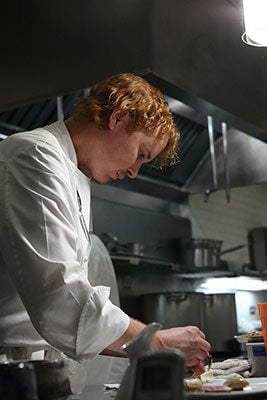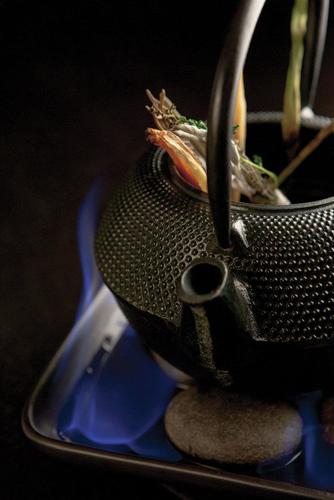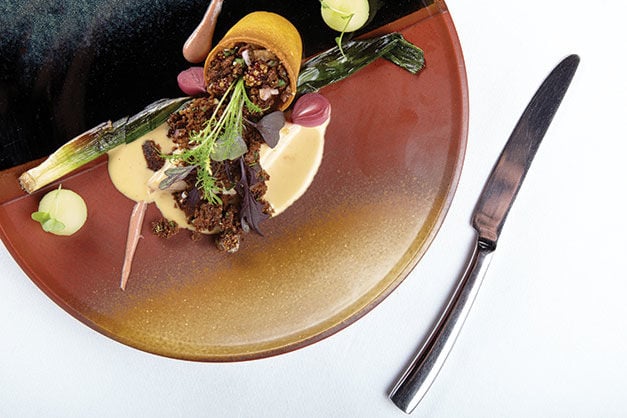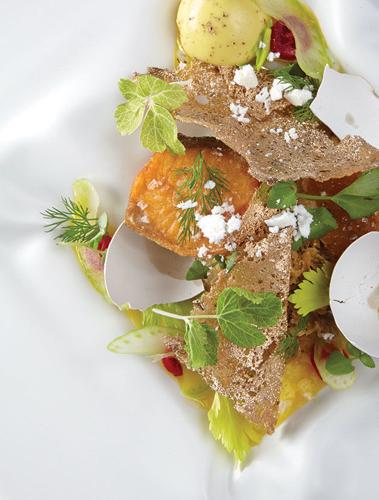The restaurateur and chef hopes when guests sit down to eat at his restaurant, Alinea, to enjoy as many as 23 small courses, they remain open to the idea that each plate contains an infinite number of emotionally subjective—and simultaneously delicious—possibilities. In today’s modern kitchen, tasty food is only the beginning. Cuisine should involve all the senses. Achatz compares the experience to walking up to a Picasso or Pollok painting. He hopes that guests feel confident in realizing their own conclusions about his food.
In 2006, Achatz’s Chicago restaurant Alinea was named the best restaurant in America by Gourmet magazine. Grant Achatz was hailed for progressive thinking in the kitchen and contemporary appeal to a new generation of curious eaters. This is not your grandmother’s kitchen or familiar food traditions snubbed from the top shelf of classic French technique. Achatz has carved a reputation of ingenuity through his use of molecular gastronomy—or modernist cuisine—combining one part mad science to two parts culinary romance.
The recent popularity of creating "food experiences," whether through ambiance or rare menu offerings, has shaped a competitive landscape of wildly diverse talent in which chefs and restaurants achieve almost celebrity-like status for serving up more than very delicious food. Achatz’s interpretation—a la modernist cuisine—challenges textures and consistency, transforming liquid to solid and solid to liquid in unexpected ways, awakening the visceral possibilities by changing the way people think about their food. He also challenges guests to interact with what they eat, asking them, politely, to please play with their food.
"Most people eat three to four times a day," Achatz explained. "When you do something that often—fork to mouth, again and again, everyday—you stop thinking about what you’re doing. I want guests to think while they eat our food."
Don’t be surprised if you’re asked to eat without your hands or to enjoy a course that begins by smelling lavender-flavored smoke. By incorporating more of the senses into an average four-hour presentation, the goal is largely about gaining an experience rather than filling the stomach.
Appearance, texture and taste are modified in modernist cuisine using ingredients like agar, a species of red algae, used as a gelling agent; or chlorophyll, found in plant cells, a natural food coloring. Achatz might prepare edible foams using a soy protein isolate called versawhip or carbonate a soup with carbon dioxide. The result is often a breathtaking presentation that evokes a sense of humor and childlike wonder.
Not only are some of the ingredients provocative, the menu descriptions can be downright confusing. Helium, green apple balloons for example, sounds more like science fiction than dessert. Beautiful the food may be, some argue that modernist cuisine is more of a gimmick than a truly great meal.
"This type of cooking caught fire in 2004 and exploded by 2005," Achatz said. "It was very popular in the media because it didn’t sound tasty. Our goal was to take raw ingredients and really transform them."
Inside his earliest kitchen, it was common to see test tubes and petri dishes mixed about with utensils. These laboratory tools born out of necessity, served very new and exciting applications in the culinary arena.
"Scientific technique is not the cornerstone of what we do," Achatz explained. "Science is a tool to help us achieve progressive American cuisine with global influence."
It’s difficult to categorize the techniques Achatz and his colleagues use to personify experiences that stimulate most of the senses—though in some ways, for Achatz, taste was the single most troubling, yet important, sense of all. In 2007, Achatz catapulted into the spotlight after he announced his diagnosis of stage four cancer of the mouth. He received radiation therapy that all but eliminated his sense of taste for several months. The irony of his battle with cancer was happily met with remission later that year. In 2011, Achatz shared his journey in, "Life, On the Line," co-authored by Alinea collaborator Nick Kokonas.
With such resounding success at Alinea and the welcome embrace of his interpretation of modernist cuisine, taking it further meant opening Next. Established in 2011, Next is food drama in a fully immersive plot. The interior presentation, menu, costuming and ambiance change every three months, like an off-Broadway show. In fact, patrons don’t make reservations to dine; they purchase tickets.
"My team and I will hone in on a specific time and place," explained Grant Achatz. "For the beginning of 2014, we’re focusing on the Chicago steakhouse." (Update: steakhouse is now open, called NEXT)
It’s an elaborate show from the stemware and musical score to the flavors themselves that represent a cast of characters staring in each separate dish. While the current "Chicago Steakhouse" menu may nuance a homecoming of sorts for the Chi Town restaurant, less expected menus have been wholly vegan. More avant-garde still was a menu called "Childhood" that focused on comforting classics like peanut butter and jelly, mac n’ cheese and hot cocoa.
These elementary or simplified themes are not meant to be contrary to the expectations of a fine dining palate or price. Instead, they have worked to the opposite effect and allowed Grant Achatz more freedom to express the vision he and his team dream up every few months.
"It is humbling to know that people are looking at what you do," Grant Achatz said. "But it adds a lot of pressure, and you don’t ever want to screw up." The well-decorated chef has won countless honors from the James Beard Foundation and ranks highly in several annual dining polls. "But at some point, you’re not the only one doing what you’re doing," he concluded.
Achatz bravely embraced the notion that food could be more than a process to collect sustenance for the body. He has opened the doors for countless other chefs who look to modernist cuisine as the new frontier in experiential dining.
"Some people just ‘get it,’" he said. "I just want people to be open to the idea that food can be art."











(0) comments
We welcome your comments
Log In
Post a comment as Guest
Keep it Clean. Please avoid obscene, vulgar, lewd, racist or sexually-oriented language.
PLEASE TURN OFF YOUR CAPS LOCK.
Don't Threaten. Threats of harming another person will not be tolerated.
Be Truthful. Don't knowingly lie about anyone or anything.
Be Nice. No racism, sexism or any sort of -ism that is degrading to another person.
Be Proactive. Use the 'Report' link on each comment to let us know of abusive posts.
Share with Us. We'd love to hear eyewitness accounts, the history behind an article.